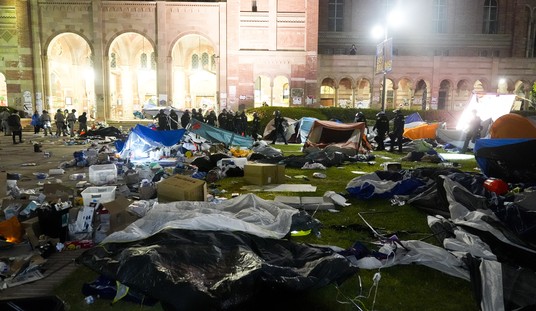[jwplayer config=”pjm_lifestyle” mediaid=”41775″]
“There was music in the cafés at night
And revolution in the air”– Bob Dylan, “Tangled Up in Blue”
Finally, a movie has arrived that treats the story of the New Left honestly and in a realistic, mature manner. That film is not Robert Redford’s dreadful The Company You Keep, a paean to the Weather Underground, but the movie by the French director Olivier Assayas, Something in the Air. It takes place in various European locales in the summer of 1971, when the hopes of the European revolutionaries were shattered after the failure of 1968 to lead to revolution. Assayas’ film covers an assorted group of European New Leftists and some American tourist counterparts as they attempt to both get on with their lives and, for some, to keep alive their crushed hopes in a period of ideological and political retreat.
Assayas, who made the quintessential and powerful biographical movie Carlos about Carlos the Jackal, the Left’s most well-known ’70s and 80’s terrorist, now turns his attention in particular to the plight of the young graduating high school student Gilles, played by Clement Metayer, and his new girlfriend, Christine, played by Lola Creton. Each takes different paths. Gilles is guilt ridden over his desire to become an artist and study painting instead of serving the revolution, while Christine, plagued with guilt over her bourgeois existence, opts instead to live with an older man in a revolutionary collective and to devote herself to the task of organizing the proletariat in France and Italy. (All she does, we learn, is shop, cook and clean for the male comrades, as well as provide sex.)
The power of Assayas’ movie is that it takes place in real time, instead of flashbacks and narrative based in the present, as aging radicals try to come to terms with their past. We see these young people facing the options in front of them, each deciding which way to turn, as they experience the pulls to go one way and the warning signs that they had better think twice before acting on their impulses.
[jwplayer config=”pjm_lifestyle” mediaid=”41774″]
The movie is in many ways a critique of France’s once most highly regarded leftist filmmaker, Jean-Luc Godard, who made many pretentious and preening leftist screeds in that very era. Indeed, we meet a Godard-like filmmaker devoted to chronicling the revolution and spouting its message, as well as radical film collectives that screen horrendous didactic and boring documentaries for small leftist audiences, meant to encourage them to keep “making the revolution.” (The films they watch, as we learn in the end credits, were in fact real leftist documentaries of that era.) Many of them tout the “victories” of Third World revolutionaries that we now know turned out to be failures or led to new totalitarian regimes like that of Pol Pot’s Cambodia. The viewer is well aware that Pol Pot himself learned his Marxism-Leninism while studying at the Sorbonne. Similarly, we see Gilles’ high school class as his politics teacher instructs the class in the intricate dialectics of Marxism, asking the class to explain why Marx and Engels rejected the “revisionists” of their theory.
The documentary they watch takes place in Florence, and was a real film about Laos, in which the peasant army is shown marching to victory. Gilles and Christine watch the screening and the discussion afterwards, as revolutionary Italians mock the director’s leftist credentials. The dialogue of these revolutionaries is at the same time hilarious, arcane, arrogant and sad. “Shouldn’t revolutionary cinema employ revolutionary syntax?” asks one communist audience member. The director answers: “Such a style would be a shock to the proletariat. Our role is to enlighten them.” The audience member has an answer. Wasn’t the filmmaker in fact revealing an “individualist style of the petit bourgeoisie?” The director has yet another answer: “You can’t make entertainment in revolutionary times.” Gilles has a more accurate thought, which he boldly tells the others with him. They are all “boring films” with “primitive politics.”
Assayas, in fact, has produced a film that is really about his own experience as a young radical of that era. His counterparts enthusiastically start by giving out leaflets for meaningless demonstrations, and quickly graduate to vandalism and Molotov cocktails, one of which harms a school guard and ruins his life. Later they join their comrades in violent street demonstrations against the police, who, since 1968, were an ubiquitous presence in the streets of Paris each summer, vigilant against any repeat of the events that almost led to the collapse of Charles de Gaulle’s government a few years earlier.
Indeed, that very summer I was in Paris, and recall the police with sub-machine guns throughout the city. Once I was stopped in a car and asked for my passport, as the police, viewing a car with a few young men in it, decided to check us out and not take any chances. The graffiti on buildings and the revolutionary slogans and signs still had not all been taken down, and the whiff of revolution was still in the air, just as Assayas portrays it.
An American New Leftist, Leslie played by India Salvor Menuez who reminds one of a young Julianne Moore, captures the revolutionary posturing of a young American taking time off to live the counter-cultural and revolutionary dream in Europe. Leslie becomes the lover of an artistic French revolutionary, traveling with him to Nepal, where she and others live the adventurous life of smoking dope, having sex, and regularly getting stoned. As summer comes to an end, she has an abortion, abandons the revolution, and returns home to New York where she will finish her studies at Juilliard and ready herself for a career in dance. Ever the pragmatist, she makes a classic American conclusion. She realizes that the hopes and dreams of her New Left summer friends would lead nowhere, and she chooses reality after a summer’s fling.
What is most striking is that the soundtrack of their lives was American and British rock and folk music. Assayas’ choice is not the obvious ones; there is no Bob Dylan, although we see LPs displayed as Gilles picks records to listen to while painting, of the Byrds’ Sweetheart of the Rodeo and a blues album by Hot Tuna. We hear Mike Heron, Clive Palmer and Robin Williamson of The Incredible String Band, a highly influential ’60s group but hardly the Rolling Stones. In one sequence, at an outdoor party of the young revolutionaries, a young American New Left folksinger tourist serenades the European comrades with one of the late Phil Ochs’ least remembered songs, which he sings in its entirety, as Leslie explains its meaning and context to the assembled listeners. (The song is actually about an individual who once blurbed one of my books.)
The film, realistically and honestly filmed, presents viewers with the choices the director’s subjects faced as they enter adulthood. Assayas does not preach or hector. We watch, of course, from our present context, and we see a group of narcissistic, foolish yet idealistic, privileged children seeking to become revolutionaries. Some give up the dream, while others perish. Rather than glamorize or eulogize these New Leftists as principled and heroic youngsters, Assayas lets us see them as they were.
Assayas himself, of course, became a filmmaker in his own right, often making movies today that confront the truth about the leftist illusions of his youth. We get a glimpse of this when Gilles picks up a book by Simon Leys, an expose of Maoist China published in the ’60s, at a time when his comrades all were singing the praises of the Cultural Revolution and extolling the virtues of Maoism. Even then, we know that Gilles’ future is most likely promising, since back in the day, he could read forbidden literature and glimpse the truth about what revolution really meant for those who suffered living in the society its spokesman created.
The film opened this week in Landmark theaters and, for those who have “On Demand” on their cable systems, can be rented for home viewing.
*****









Join the conversation as a VIP Member